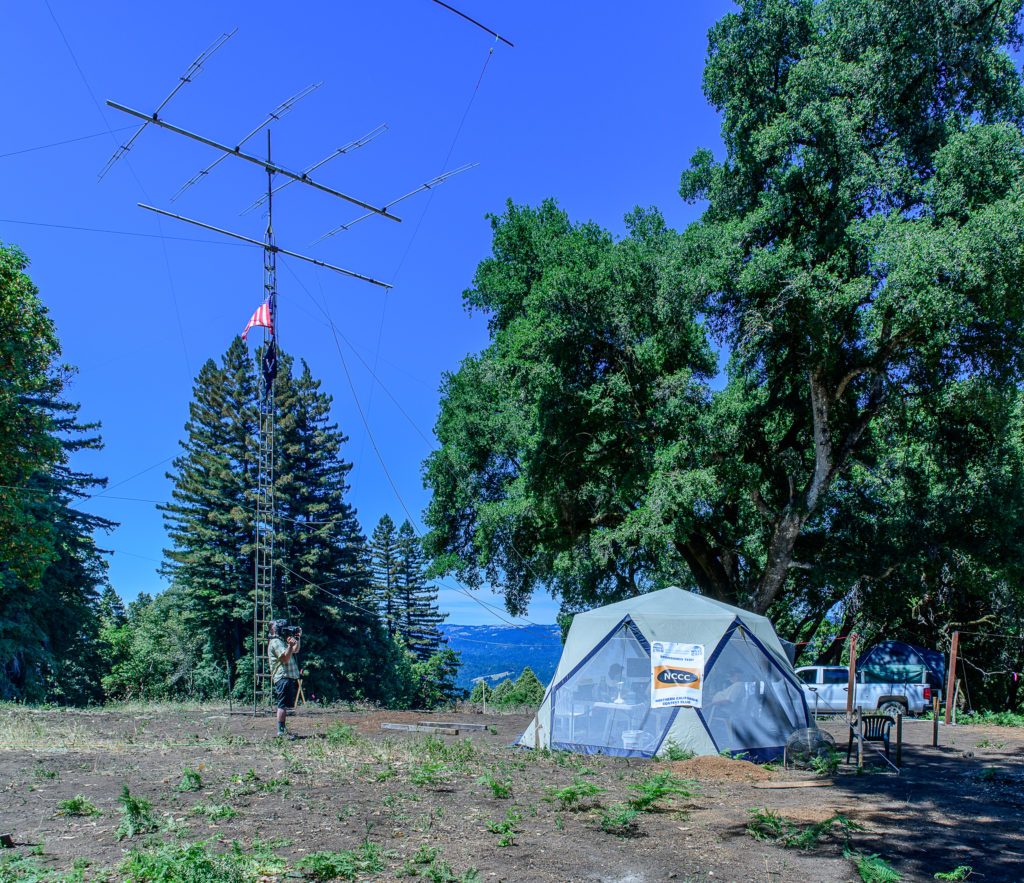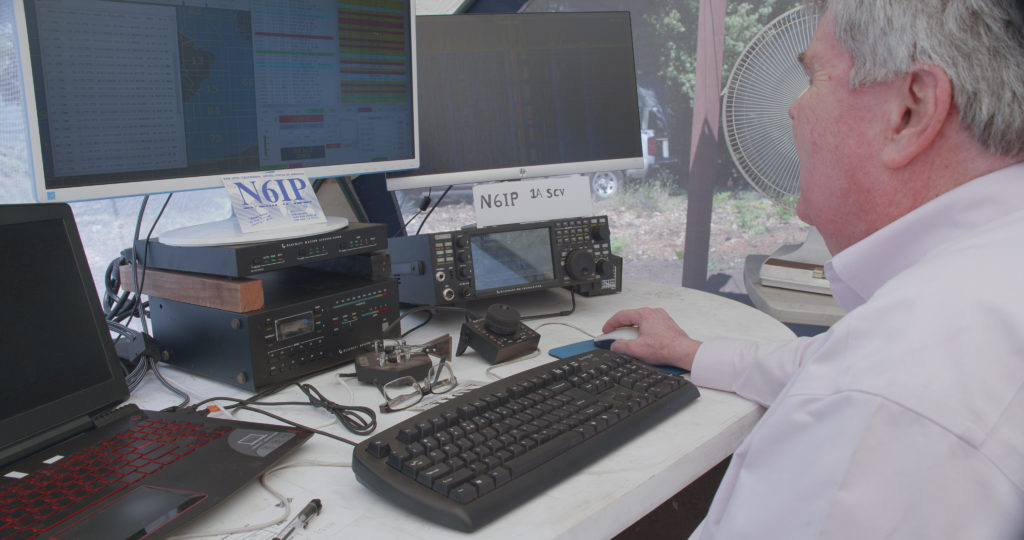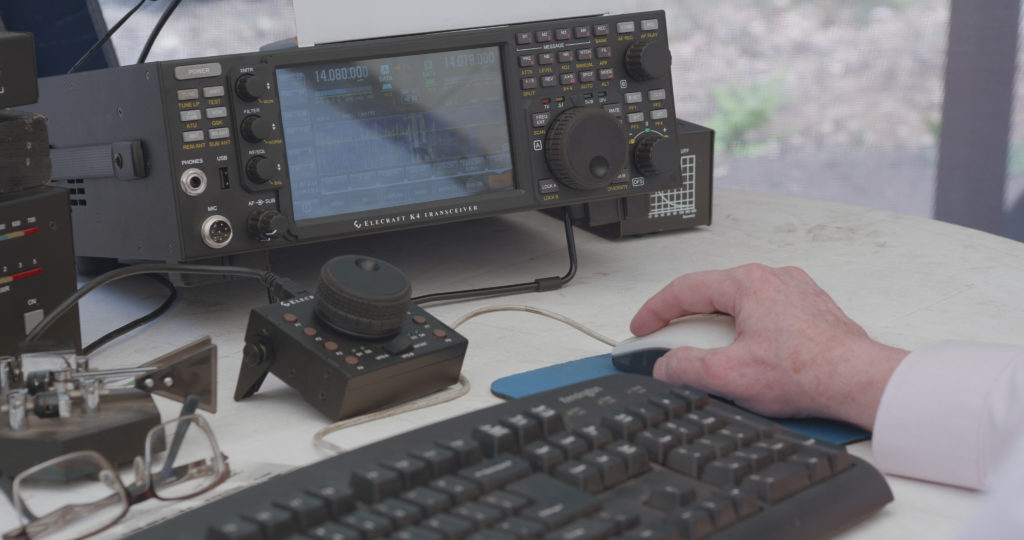To say we live in interesting times would be an understatement. However, to have participated in Field Day 2020 underscores amateur radio’s ability to adapt to conditions, while building and maintaining social contacts.
Our story began about a month before field day. Our host asked a small group of local hams if we would be interested in operating a 1A station “with power” in the Santa Cruz Mountains in California.
My immediate reaction was a mix of emotions. First, I’d never operated a station over 100 watts, and this station would be running around 550 watts, what an opportunity! Second, with concerns of COVID-19, how difficult would it be to set up and operate a Field Day site? And Last, how well did my skills fit into the team being assembled. As Paul Harvey used to say, “And now, for the rest of the story.” I couldn’t pass on this event.
Field Day planning is an art. And even more so when it’s done with a minimum crew, when you are erecting a tower, and balancing 3 antennas (a tri-bander for 10–15–20 m, 40 m wire Yagi, and an 80 m dipole—plus a beverage). I’d recommend that you start simply, and build up to taking on a complex effort. However, it helps to learn from someone who is experienced, a visionary, and at times a MacGyver. Our host, Bob Wolbert (K6XX) happened to be all of those. Having worked with him in the past, I knew whatever plan he had in mind would work. Also I knew, with the minimum crew, it would be a Field Day where “all hands on deck” was expected.
Friday morning, just 24 hrs. before the event, we arrived on site and started the assembly of the tower on a 90+ °F sunny day. First adding the boom and spreaders for the 40 m wire Yagi to the tower, and then attaching the 4 element triband Yagi. The 40 ft. tower was then raised and guyed. The 80 m dipole would be hoisted up into position, as we flew “the colours” on the tower.

Friday afternoon we began the station setup and configuration. We knew we wanted to cover the basic modes of Sideband, CW and Digital, so we needed to ensure the configurations and PC software was correctly installed and operating. Tom Stollar (KW6S) was our Digital and VHF/UHF captain. Reed Cotton (N1WC an ARRL VE and instructor) and I (K6GHA) were focused on Phone operation. Our host (K6XX), whose name and call you may remember from the 2018 WRTC, was again the MacGyver focusing on CW. Bob also operated all other modes, and configured the Elecraft K4. We were one of a handful of test sites for the new Elecraft K4. I could only think “how cool is this?!” [At the time of this publication, the Elecraft K4 has not yet begun initial shipments. —Ed.]

The station set up proceeded without a hitch, and within five hours we were ready to copy the ARRL W1AW CW bulletin at 5:00 p.m. Pacific. All went mostly according to plans. In my limited experience, an uneventful set up for Field Day can only be attributed to good pre-planning, team communication and coordination, and preparedness for the unexpected. Safety, contingencies, and backup resources are all a part of that preparedness.
Saturday morning greeted us with a sunny and dry day in the high 80s, and a growing excitement about the event ahead of us. Little did we know what fun Mother Nature planned for this year.
We established the schedule of operation. The four of us, ensured we would be using our own headsets, addressed best social and sanitizing practices for the open air screened mesh tent we were using, and finalized the systems setup for digital operations. The clock ticked to 18:00 UTC and it was about 86°F and calm. We were ready.

The operating schedule was set up to guide the team though an introduction to the Elecraft K4, build station and trade-off techniques and awareness, and to ensure mode configurations were operating efficiently. The first ½ hr. made sure we were working on all bands, antennas, and modes, and acted as a guided tour for the new K4 touch screen features. You may ask why we didn’t do this prior to the start of Field Day, and the simple answer was timing and the availability of the Elecraft K4. However, getting up to speed went smoothly. After the first half hour, each operator took a one hour shift to test their understanding, and become familiar with the radio and band conditions. The number of 1D stations was noted quite quickly in response to our CQs.
I started my one hour shift and was amazed at the clarity and ease of listening with the audio from the K4. Even in a pile up I was able to sort most calls. I have a K3, and the improvements were noticeable. As I got used to the radio, my efficiency improved and just towards the end of my first hour I had settled into a fun rhythm and rate. It also was my first time using a beverage antenna and diversity reception. Having a different receiver in each ear was a little distracting for me at first. However it really opened up possibilities for operational improvements at my own home station. As Bob said “It made my 40 m rate much better, listening to the Yagi in my left ear and the Beverage on the right. Reduced repeats down to nearly none.”
It gave me a greater appreciation of what Elecraft has produced. My focus on making the next contact was so intense it took a tap on the shoulder to be told my time was up. I was having a lot of fun! I reluctantly unplugged and completed the operator change. We then settled into our standard 2 hr. shifts of operation throughout most of the rest of the event.
Dusk fell on the West Coast and we were treated to a fire red reflection of the setting sun off the high forming wispy clouds. 20 m was still active. As the sun set, there was a noticeable change in the weather. The wind had increased to about 10 mph in gusts, and the temperature was beginning to drop. I retreated to my sleeping bag for a quick nap before my 1:00 a.m. shift was to begin.
I awoke, excited for my shift, and was glad to have brought a jacket. The winds were now about 10 to 12 mph steady, and the temps had plummeted into the high 40s as I started. In the next 4 hrs, the weather didn’t improve. At the end of my 2hrs, Bob checked in and asked if I could do another shift. I couldn’t answer fast enough… SURE! He took over for 30 minutes, while I took the time to warm up a little bit, grab my sleeping bag as a wrap against the cold, and relieved him to pick up again on 40 m and 80 m. In that short time the wind started to really gust. It was over 15 mph and sometimes higher. I could tell it was blowing because the fan in the tent, which was turned off, was freewheeling on its own and at a good rate! The temp was now down into the low 40s. Not sure of the wind chill, but with an open tent layout, and expecting warmer conditions, I know I made a sight for Tom who arrived at 4:00 a.m. He quickly retreated to get a blanket to use as his wrap, and we completed the shift change.
As dawn broke at our elevation of 2600 ft., we were in the clouds. A thick marine layer of fog and dampness moved in as the winds abated. Band conditions improved, by 9:30 a.m. the clouds were breaking, and the temps were now on the rise again. The warmth and band activity was appreciated.
There were no issues heading to the finish line of the event, and we finished with Bob at the helm closing Field Day out with CW. When 11:00 a.m. arrived, we shut down the radio, took a breath, and began the station takedown.
In our case, the station teardown was as uneventful as the set up. Within about an hour and a half, the tower was lowered, and the antennas removed. A quick, and much appreciated, snack provided by Bob’s wife Miki boosted our spirits and motivated us to the final clean up. Ropes, guys, and lines wound up, beverage and 80 m dipole packaged up, 40 m Yagi, Tribander, and tower disassembled and ready for put away.
With planning, flexibility, and a little MacGyvering, N6IP logged contacts on all HF bands for which we had antennas. Everyone had a great time!
| Mode | Contacts |
|---|---|
| CW | 612 |
| SSB | 649 |
| Digital (FT4/FT8) | 132 |
| Total Contacts | 1393 |
Those 1393 QSOs led to a QSO Score of 2137 points.
| Bonus | Points |
|---|---|
| 100% Emergency Power | 100 |
| Media Publicity | 100 |
| Field Day Message | 100 |
| Web Entry | 50 |
| Total Bonus Points | 350 |
The QSO Score plus the Bonus Points gave us a Field Day score of 2487 points.
Even in these strange times, challenging conditions, and an added surprise from Mother Nature, Field Day 2020 was all, and more, than I expected. Saying I had a great time doesn’t capture the full essence of working with a great team, on a great station, and running with power.
Having that additional power was a treat I won’t soon forget. As we broke down the station, Bob reminded me we were running an Elecraft KPA500 amp for Field Day, and said with a wink “you could even go another 4 dB up in power, to 1500 W someday.” As a Low Power operator, I am reminded often by Bob, “More power to you.” I can’t wait for an opportunity at full power!
As we departed, the team agreed that our operation fulfilled everyone’s expectation of the most important part of Field Day, great FUN.